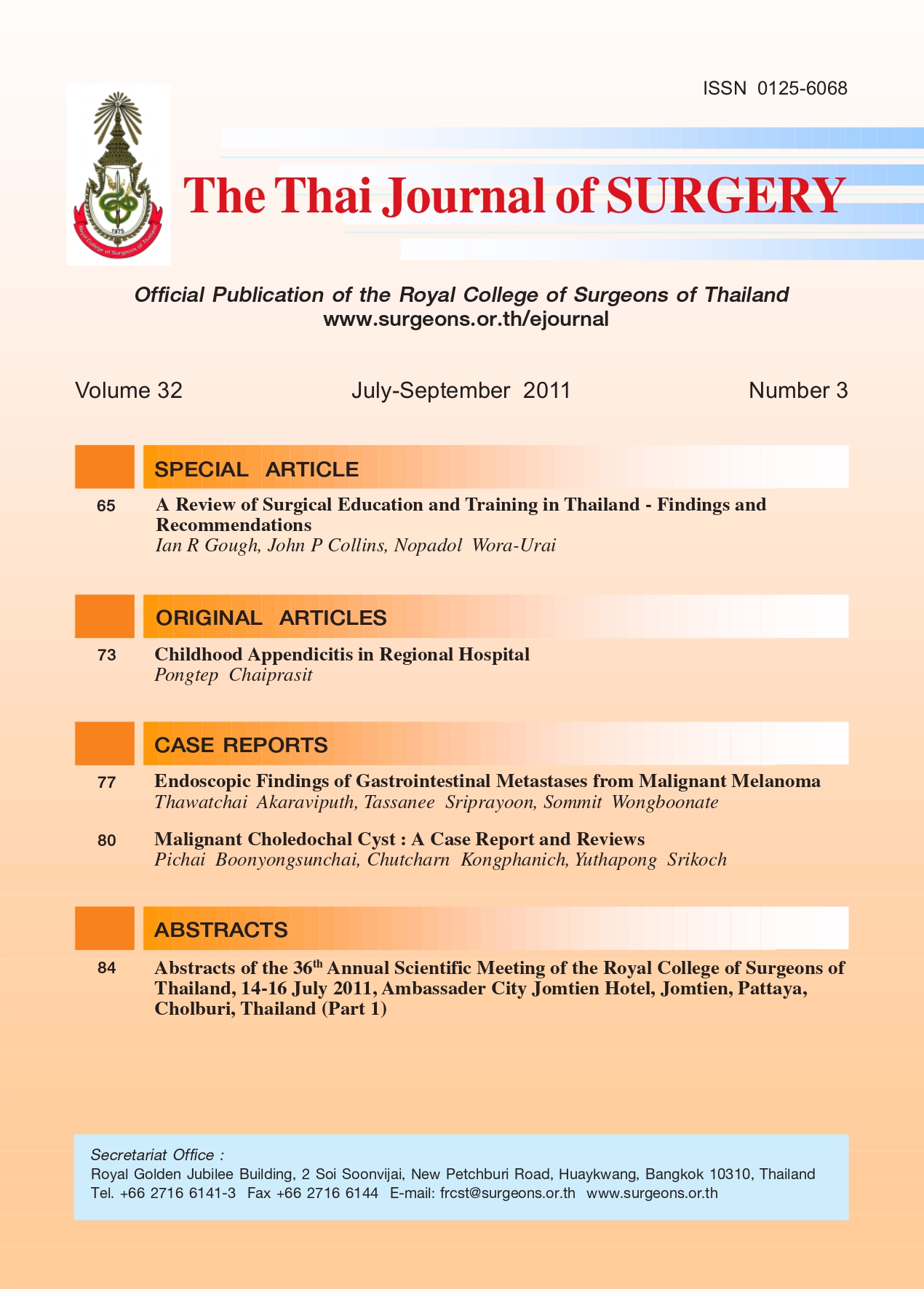Childhood Appendicitis in Regional Hospital
Keywords:
childhood appendicitis, regional hospitalAbstract
Background: Appendicitis is one of the most common intraabdominal conditions that needs surgery inchildren.
Objectives: The purpose of the study was to find the nature of childhood appendicitis which may be used
as the representative data of regional hospitals in Thailand under universal coverage of national health care
scheme.
Materials and Methods: Medical records of the patients aged under 15 years admitted to Chonburi
hospital with the diagnosis of appendicitis and abdominal pain suspected of appendicitis between 2007 and 2010
were reviewed. The patients’ data including demographics, modes and results of treatment were collected.
Descriptive statistics were used to analyze the data.
Results: There were 660 patients in which 333 of them were referred cases (50.5%). Four hundred and
seventy-five patients underwent appendectomies (72% of admitted cases). The average age of patients who had
appendectomies was 9.6 years. Boys were predominated with 56.4%. Pathological specimens of the appendices
were obtained in 463 patients which revealed appendicitis and normal appendix rates of 86.6% and 11.7%
respectively. The appendicitis rupture rate was 35.4%. Enterobiasis was found in 1.7%. The highest rupture
rate of 65.4% was found in the age group of 0-4 years. Patients with the symptom of abdominal pain between
24 and 48 hours had the highest rate of appendicitis rupture (70.7%). All patients had appendectomies
performed within 24 hours after admission with the average time of 4 hours and 45 minutes. The median
hospital stay was 3 days. One patient died of appendicitis rupture. Mortality rate was 0.2%.
Conclusions: The appendicitis rupture rate was high in children. This might be prevented by early
diagnosis.
References
Pediatric appendicitis rupture rate: disparities despite
universal health care. J Pediatr Surg 2008;43:1964-9.
2. Komenaka IK, Wu GCH, Lazar EL, Cohen JA. Strongyloides
appendicitis: unsual etiology in two siblings with chronic
abdominal pain. J Pediatr Surg 2003;38:1-3.
3. Clyde C, Bax T, Merg A, et al. Timing of intervention does not
affect outcome in acute appendicitis in a large community
practice. Am J Surg 2008;195:590-3.
4. Muehlstedt SG, Pham TQ, Schemling DJ. The management
of pediatric appendicitis: a survey of North American
pediatric surgeons. J Pediatr Surg 2004;39:875-9.
5. Birkhahn RH, Briggs M, Datillo PA, Van Deusen SK, Gaeta TJ.
Classifying patients suspected of appendicitis with regard
to likelihood. Am J Surg 2006;191:497-502.
6. Lessin MS, Chan M, Catllozzi M, et al. Selective use of
ultrasonography for acute appendicitis in children. Am J
Surg 1999;177:193-6.
7. Smink DS, Finkelstein JA, Garcia Pena BM, Shannon MW,
Taylor GA, Fishman SJ. Diagnosis of acute appendicitis in
children using a clinical practice guideline. J Pediatr Surg
2004;39:458-63.
8. Meier DE, Guzzetta PC, Barber RG, Hynan LS, Seetharamaiah
R. Perforated appendicitis in children: is there a best
treatment?. J Pediatr Surg 2003;38:1520-4.
9. Fraser JD, Aruayo P, Sharp SW, et al. Accuracy of computed
tomography in predicticting appendiceal perforation. J
Pediatr Surg 2010;45:231-5.
10. Morrow SE, Newman KD. Current management of
appendicitis. Sem Pediatr Surg 2007;16:34-40.
11. Yardeni D, Hirschl RB, Drongowski RA, et al. Delayed versus
immediate surgery in acute appendicitis: do we need to
operate during the night? J Pediatr Surg 2004;39:464-9.
Downloads
Published
How to Cite
Issue
Section
License
Articles must be contributed solely to The Thai Journal of Surgery and when published become the property of the Royal College of Surgeons of Thailand. The Royal College of Surgeons of Thailand reserves copyright on all published materials and such materials may not be reproduced in any form without the written permission.


